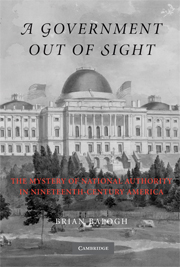Book contents
- Frontmatter
- Contents
- Acknowledgments
- 1 Introduction: Why Look Back?
- 2 How Americans Lost Sight of the State: Adapting Republican Virtue to Liberal Self-Interest
- 3 Between Revolutions: The Promise of the Developmental Vision
- 4 “To Strengthen and Perpetuate that Union”: Republican Political Economy
- 5 Outside the Boundaries: “Powers and Energies in the Extreme Parts”
- 6 The Uncontested State: Letters, Law, Localities
- 7 Restoring “Spontaneous Action and Self-Regulation”: Civil War and Civil Society
- 8 Judicial Exceptions to Gilded Age Laissez-Faire
- 9 “A Special Form of Associative Action”: New Liberalism and the National Integration of Public and Private
- 10 Conclusion: Sighting the Twentieth-Century State
- Index
10 - Conclusion: Sighting the Twentieth-Century State
Published online by Cambridge University Press: 05 August 2012
- Frontmatter
- Contents
- Acknowledgments
- 1 Introduction: Why Look Back?
- 2 How Americans Lost Sight of the State: Adapting Republican Virtue to Liberal Self-Interest
- 3 Between Revolutions: The Promise of the Developmental Vision
- 4 “To Strengthen and Perpetuate that Union”: Republican Political Economy
- 5 Outside the Boundaries: “Powers and Energies in the Extreme Parts”
- 6 The Uncontested State: Letters, Law, Localities
- 7 Restoring “Spontaneous Action and Self-Regulation”: Civil War and Civil Society
- 8 Judicial Exceptions to Gilded Age Laissez-Faire
- 9 “A Special Form of Associative Action”: New Liberalism and the National Integration of Public and Private
- 10 Conclusion: Sighting the Twentieth-Century State
- Index
Summary
By drawing together countercurrents in the literature – eddies in what is otherwise a torrent of popular and scholarly interpretation that ignores nineteenth-century national authority, A Government Out of Sight addresses some of the questions raised in the introduction. That nineteenth-century Americans did not want the General Government involved in their lives, that they preferred to leave things to state and local government and a free market unencumbered by government intervention, and that they got their wish – a national government that did not do anything important – has informed interpretations of the nineteenth century. It continues to frame twenty-first-century political debate, with partisans dividing over the battle whether to resurrect or bury America's laissez-faire tradition. The alternative narrative sketched in the previous pages suggests that the fundamental historical premise upon which progressives and conservatives have waged war for the past one hundred. Years is flawed. The battle between “big” and “small” government is grounded in a false historical premise.
The mystery of national authority in nineteenth-century America can be resolved once we recognize that although the United States did indeed govern differently than its industrialized counterparts, it did not govern less. Americans did, however, govern less visibly. The key feature that distinguished the United States in the nineteenth century was the preference among its citizens for national governance that was inconspicuous. Americans preferred to use the language of the law, the courts, trade policy, fiscal subsidies – supported by indirect taxes – and partnerships with nongovernmental partners instead of more overt, bureaucratic, and visible interventions into the political economy.
Capitalizing on this state-centered conception of nineteenth-century history has important consequences for the way we interpret the twentieth century.
- Type
- Chapter
- Information
- A Government Out of SightThe Mystery of National Authority in Nineteenth-Century America, pp. 379 - 400Publisher: Cambridge University PressPrint publication year: 2009



